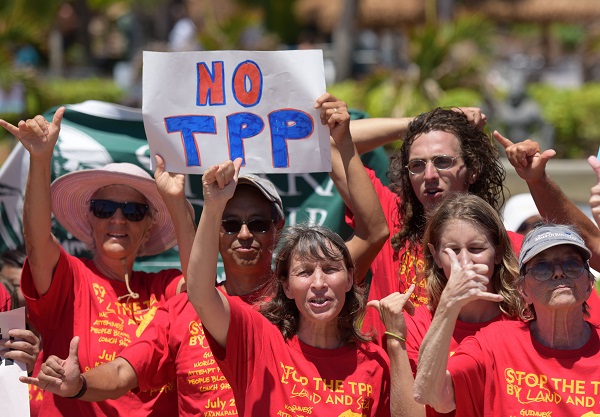

Follow us on:  
|

Latest

The TPP has not been popular among many Republicans and some sectors of the US workforce. People attend a rally protesting the Trans-Pacific Partnership (TPP) in Maui, Hawaii, the United States, July 29, 2015 [Xinhua]
On Monday, Trump signed an executive order to withdraw from the TPP, which has been a cornerstone of Barack Obama’s policy to counter China’s growing global influence.
Countries which had signed on to the TPP less than a year ago, such as Australia, Brunei, Vietnam, Canada, Malaysia, Mexico, New Zealand, Peru, Singapore, Chile and Japan are now wondering what kind of trade relationship will exist with the US.
Japan, Mexico and Australia have already signaled that they will try and keep it functional and/or modify it into something similar.
Australian Prime Minister Malcolm Turnbull has told journalists that there is also an opportunity for China to join the TPP.
But many of America’s allies who initially signed on to the TPP have expressed concern that it could fall apart altogether if Washington withdrew.
Japanese Prime Minister Shinzo Abe had previously signaled that America’s withdrawal from the treaty would amount to its demise.
“There’s no doubt that there would be a pivot to the Regional Comprehensive Economic Partnership (RCEP) if the TPP doesn’t go forward,” Abe told an upper house committee, according to the Japanese Kyodo news agency, in November.
RCEP groups the 10 members of the Association of South East Asian Nations plus China, Japan, South Korea, India, Australia and New Zealand, but not the United States.
“The RCEP doesn’t include the United States, leaving China the economy with the largest gross domestic product,” he added.
Chinese officials have said that Peru and Chile had signaled interest in joining the RCEP.
The China-proposed Free Trade Area of the Asia Pacific (FTAAP) is now likely to be in focus as the TPP appears to crumble.
Calling the TPP unfair and damaging to US economic prospects, Trump signaled in November following his election win that he would negotiate bilateral trade treaties with different countries in order to bring jobs back to the US.
His renewed pledge to withdraw from the TPP also comes a day after a final communiqué from the Asia-Pacific Economic Cooperation (APEC) Summit in Lima, Peru reaffirmed the member states commitment to free trade and combating protectionism.
Meanwhile, Trump has signaled his intention to sign another executive order to renegotiate the North American Free Trade Agreement with Canada and Mexico.
The BRICS Post with inputs from Agencies

© 2017 BRICS Media Limited. All rights reserved. Registered in England and Wales. No.8133697. Registered office: Devonshire House 60 Goswell Road London, EC1M 7AD
57 founding members, many of them prominent US allies, will sign into creation the China-led Asian Infrastructure Investment Bank on Monday, the first major global financial instrument independent from the Bretton Woods system.
Representatives of the countries will meet in Beijing on Monday to sign an agreement of the bank, the Chinese Foreign Ministry said on Thursday. All the five BRICS countries are also joining the new infrastructure investment bank.
The agreement on the $100 billion AIIB will then have to be ratified by the parliaments of the founding members, Chinese Foreign Ministry spokesman Lu Kang said at a daily press briefing in Beijing.
The AIIB is also the first major multilateral development bank in a generation that provides an avenue for China to strengthen its presence in the world’s fastest-growing region.
The US and Japan have not applied for the membership in the AIIB.
